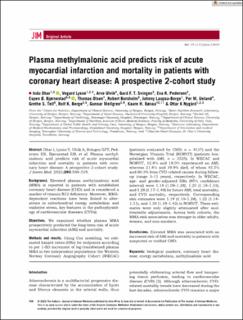Plasma methylmalonic acid predicts risk of acute myocardial infarction and mortality in patients with coronary heart disease: A prospective 2-cohort study
Dhar, Indu; Lysne, Vegard; Ulvik, Arve; Svingen, Gard Frodahl Tveitevåg; Pedersen, Eva Kristine Ringdal; Bjørnestad, Espen Øglænd; Olsen, Thomas; Borsholm, Robert Andre; Laupsa-Borge, Johnny; Ueland, Per Magne; Tell, Grethe Seppola; Berge, Rolf Kristian; Mellgren, Gunnar; Bønaa, Kaare Harald; Nygård, Ottar Kjell
Journal article, Peer reviewed
Published version

Åpne
Permanent lenke
https://hdl.handle.net/11250/3117991Utgivelsesdato
2023Metadata
Vis full innførselSamlinger
- Department of Clinical Science [2318]
- Registrations from Cristin [9791]
Sammendrag
Background
Elevated plasma methylmalonic acid (MMA) is reported in patients with established coronary heart disease (CHD) and is considered a marker of vitamin B12 deficiency. Moreover, MMA-dependent reactions have been linked to alterations in mitochondrial energy metabolism and oxidative stress, key features in the pathophysiology of cardiovascular diseases (CVDs).
Objectives
We examined whether plasma MMA prospectively predicted the long-term risk of acute myocardial infarction (AMI) and mortality.
Methods and results
Using Cox modeling, we estimated hazard ratios (HRs) for endpoints according to per 1-SD increment of log-transformed plasma MMA in two independent populations: the Western Norway Coronary Angiography Cohort (WECAC) (patients evaluated for CHD; n = 4137) and the Norwegian Vitamin Trial (NORVIT) (patients hospitalized with AMI; n = 3525). In WECAC and NORVIT, 12.8% and 18.0% experienced an AMI, whereas 21.8% and 19.9% died, of whom 45.5% and 60.3% from CVD-related causes during follow-up (range 3–11 years), respectively. In WECAC, age- and gender-adjusted HRs (95% confidence interval) were 1.18 (1.09–1.28), 1.25 (1.18–1.33), and 1.28 (1.17–1.40) for future AMI, total mortality, and CVD mortality, respectively. Corresponding risk estimates were 1.19 (1.10–1.28), 1.22 (1.14–1.31), and 1.30 (1.19–1.42) in NORVIT. These estimates were only slightly attenuated after multivariable adjustments. Across both cohorts, the MMA-risk association was stronger in older adults, women, and non-smokers.
Conclusions
Elevated MMA was associated with an increased risk of AMI and mortality in patients with suspected or verified CHD.
